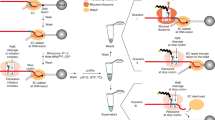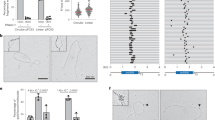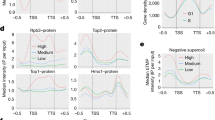Abstract
Head-on encounters between the replication and transcription machineries on the lagging DNA strand can lead to replication fork arrest and genomic instability1,2. To avoid head-on encounters, most genes, especially essential and highly transcribed genes, are encoded on the leading strand such that transcription and replication are co-directional. Virtually all bacteria have the highly expressed ribosomal RNA genes co-directional with replication3. In bacteria, co-directional encounters seem inevitable because the rate of replication is about 10–20-fold greater than the rate of transcription. However, these encounters are generally thought to be benign2,4,5,6,7,8,9. Biochemical analyses indicate that head-on encounters10 are more deleterious than co-directional encounters8 and that in both situations, replication resumes without the need for any auxiliary restart proteins, at least in vitro. Here we show that in vivo, co-directional transcription can disrupt replication, leading to the involvement of replication restart proteins. We found that highly transcribed rRNA genes are hotspots for co-directional conflicts between replication and transcription in rapidly growing Bacillus subtilis cells. We observed a transcription-dependent increase in association of the replicative helicase and replication restart proteins where head-on and co-directional conflicts occur. Our results indicate that there are co-directional conflicts between replication and transcription in vivo. Furthermore, in contrast to the findings in vitro, the replication restart machinery is involved in vivo in resolving potentially deleterious encounters due to head-on and co-directional conflicts. These conflicts probably occur in many organisms and at many chromosomal locations and help to explain the presence of important auxiliary proteins involved in replication restart and in helping to clear a path along the DNA for the replisome.
This is a preview of subscription content, access via your institution
Access options
Subscribe to this journal
Receive 51 print issues and online access
$199.00 per year
only $3.90 per issue
Buy this article
- Purchase on Springer Link
- Instant access to full article PDF
Prices may be subject to local taxes which are calculated during checkout




Similar content being viewed by others
References
Mirkin, E. V. & Mirkin, S. M. Replication fork stalling at natural impediments. Microbiol. Mol. Biol. Rev. 71, 13–35 (2007)
Pomerantz, R. T. & O’Donnell, M. What happens when replication and transcription complexes collide? Cell Cycle 9, 2535–2541 (2010)
Rocha, E. P. The replication-related organization of bacterial genomes. Microbiology 150, 1609–1627 (2004)
French, S. Consequences of replication fork movement through transcription units in vivo. Science 258, 1362–1365 (1992)
Olavarrieta, L., Hernandez, P., Krimer, D. B. & Schvartzman, J. B. DNA knotting caused by head-on collision of transcription and replication. J. Mol. Biol. 322, 1–6 (2002)
Mirkin, E. V. & Mirkin, S. M. Mechanisms of transcription-replication collisions in bacteria. Mol. Cell. Biol. 25, 888–895 (2005)
Mirkin, E. V., Castro Roa, D., Nudler, E. & Mirkin, S. M. Transcription regulatory elements are punctuation marks for DNA replication. Proc. Natl Acad. Sci. USA 103, 7276–7281 (2006)
Pomerantz, R. T. & O’Donnell, M. The replisome uses mRNA as a primer after colliding with RNA polymerase. Nature 456, 762–766 (2008)
Srivatsan, A., Tehranchi, A., MacAlpine, D. M. & Wang, J. D. Co-orientation of replication and transcription preserves genome integrity. PLoS Genet. 6, e1000810 (2010)
Pomerantz, R. T. & O’Donnell, M. Direct restart of a replication fork stalled by a head-on RNA polymerase. Science 327, 590–592 (2010)
Rudolph, C. J., Dhillon, P., Moore, T. & Lloyd, R. G. Avoiding and resolving conflicts between DNA replication and transcription. DNA Repair 6, 981–993 (2007)
Wang, J. D., Berkmen, M. B. & Grossman, A. D. Genome-wide coorientation of replication and transcription reduces adverse effects on replication in Bacillus subtilis. Proc. Natl Acad. Sci. USA 104, 5608–5613 (2007)
Tehranchi, A. K. et al. The transcription factor DksA prevents conflicts between DNA replication and transcription machinery. Cell 141, 595–605 (2010)
Boubakri, H., de Septenville, A. L., Viguera, E. & Michel, B. The helicases DinG, Rep and UvrD cooperate to promote replication across transcription units in vivo. EMBO J. 29, 145–157 (2010)
Heller, R. C. & Marians, K. J. Replisome assembly and the direct restart of stalled replication forks. Nature Rev. Mol. Cell Biol. 7, 932–943 (2006)
Bruand, C., Farache, M., McGovern, S., Ehrlich, S. D. & Polard, P. DnaB, DnaD and DnaI proteins are components of the Bacillus subtilis replication restart primosome. Mol. Microbiol. 42, 245–256 (2001)
Marsin, S., McGovern, S., Ehrlich, S. D., Bruand, C. & Polard, P. Early steps of Bacillus subtilis primosome assembly. J. Biol. Chem. 276, 45818–45825 (2001)
Rokop, M. E., Auchtung, J. M. & Grossman, A. D. Control of DNA replication initiation by recruitment of an essential initiation protein to the membrane of Bacillus subtilis. Mol. Microbiol. 52, 1757–1767 (2004)
Bruand, C. et al. Functional interplay between the Bacillus subtilis DnaD and DnaB proteins essential for initiation and re-initiation of DNA replication. Mol. Microbiol. 55, 1138–1150 (2005)
Smits, W. K., Goranov, A. I. & Grossman, A. D. Ordered association of helicase loader proteins with the Bacillus subtilis origin of replication in vivo. Mol. Microbiol. 75, 452–461 (2010)
Imai, Y. et al. Subcellular localization of Dna-initiation proteins of Bacillus subtilis: evidence that chromosome replication begins at either edge of the nucleoids. Mol. Microbiol. 36, 1037–1048 (2000)
Meile, J. C., Wu, L. J., Ehrlich, S. D., Errington, J. & Noirot, P. Systematic localisation of proteins fused to the green fluorescent protein in Bacillus subtilis: identification of new proteins at the DNA replication factory. Proteomics 6, 2135–2146 (2006)
Kunst, F. et al. The complete genome sequence of the gram-positive bacterium Bacillus subtilis. Nature 390, 249–256 (1997)
McGlynn, P., Al-Deib, A. A., Liu, J., Marians, K. J. & Lloyd, R. G. The DNA replication protein PriA and the recombination protein RecG bind D-loops. J. Mol. Biol. 270, 212–221 (1997)
Polard, P. et al. Restart of DNA replication in Gram-positive bacteria: functional characterisation of the Bacillus subtilis PriA initiator. Nucleic Acids Res. 30, 1593–1605 (2002)
Gabbai, C. B. & Marians, K. J. Recruitment to stalled replication forks of the PriA DNA helicase and replisome-loading activities is essential for survival. DNA Repair 9, 202–209 (2010)
Trautinger, B. W., Jaktaji, R. P., Rusakova, E. & Lloyd, R. G. RNA polymerase modulators and DNA repair activities resolve conflicts between DNA replication and transcription. Mol. Cell 19, 247–258 (2005)
Mahdi, A. A., Buckman, C., Harris, L. & Lloyd, R. G. Rep and PriA helicase activities prevent RecA from provoking unnecessary recombination during replication fork repair. Genes Dev. 20, 2135–2147 (2006)
Guy, C. P. et al. Rep provides a second motor at the replisome to promote duplication of protein-bound DNA. Mol. Cell 36, 654–666 (2009)
Nurse, P., Zavitz, K. H. & Marians, K. J. Inactivation of the Escherichia coli priA DNA replication protein induces the SOS response. J. Bacteriol. 173, 6686–6693 (1991)
Harwood, C. R. & Cutting, S. M. Molecular Biological Methods for Bacillus (John Wiley & Sons, 1990)
Griffith, K. L. & Grossman, A. D. Inducible protein degradation in Bacillus subtilis using heterologous peptide tags and adaptor proteins to target substrates to the protease ClpXP. Mol. Microbiol. 70, 1012–1025 (2008)
LeMaster, D. M. & Richards, F. M. 1H-15N heteronuclear NMR studies of Escherichia coli thioredoxin in samples isotopically labeled by residue type. Biochemistry 24, 7263–7268 (1985)
Grainger, W. H., Machon, C., Scott, D. J. & Soultanas, P. DnaB proteolysis in vivo regulates oligomerization and its localization at oriC in Bacillus subtilis. Nucleic Acids Res. 38, 2851–2864 (2010)
Acknowledgements
We thank D. Grainger, C. Lee, T. Baker, and W. K. Smits for discussions, W. K. Smits for constructing the priA-ssrA* mutant, and C. Lee, C. Bonilla, S. P. Bell, and J. D. Wang for comments on the manuscript. Work in the P.S. laboratory was supported by Biotechnology and Biological Sciences Research Council grant BB/E006450/1 and a Wellcome Trust grant 091968/Z/10/Z. Work in the A.D.G. laboratory was supported by NIH grant GM41934 and H.M. was supported in part by NIH postdoctoral fellowship GM093408. The Biotechnology and Biological Sciences Research Council and the Royal Society provided funds for a sabbatical visit of P.S. in the A.D.G. laboratory.
Author information
Authors and Affiliations
Contributions
H.M., C.M., W.H.G., A.D.G. and P.S. designed the research and analysed the results; H.M., C.M. and W.H.G. performed the experiments; H.M., A.D.G. and P.S. wrote the paper.
Corresponding authors
Ethics declarations
Competing interests
The authors declare no competing financial interests.
Supplementary information
Supplementary Information
The file contains Supplementary Figures 1-5 with legends, a Supplementary Table, a Supplementary Discussion and additional references. (PDF 1164 kb)
Rights and permissions
About this article
Cite this article
Merrikh, H., Machón, C., Grainger, W. et al. Co-directional replication–transcription conflicts lead to replication restart. Nature 470, 554–557 (2011). https://doi.org/10.1038/nature09758
Received:
Accepted:
Published:
Issue Date:
DOI: https://doi.org/10.1038/nature09758
This article is cited by
-
The in vivo measurement of replication fork velocity and pausing by lag-time analysis
Nature Communications (2023)
-
Gene inversion potentiates bacterial evolvability and virulence
Nature Communications (2018)
-
Histone H3K9 methylation is dispensable for Caenorhabditis elegans development but suppresses RNA:DNA hybrid-associated repeat instability
Nature Genetics (2016)
-
The nature of mutations induced by replication–transcription collisions
Nature (2016)
-
Transcription–replication conflicts: how they occur and how they are resolved
Nature Reviews Molecular Cell Biology (2016)
Comments
By submitting a comment you agree to abide by our Terms and Community Guidelines. If you find something abusive or that does not comply with our terms or guidelines please flag it as inappropriate.



